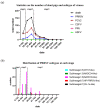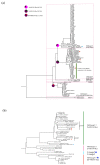First Detection of NADC34-like PRRSV as a Main Epidemic Strain on a Large Farm in China
- PMID: 35055980
- PMCID: PMC8778757
- DOI: 10.3390/pathogens11010032
First Detection of NADC34-like PRRSV as a Main Epidemic Strain on a Large Farm in China
Abstract
The newly emerged sublineage 1.5 (NADC34-like) porcine reproductive and respiratory syndrome virus (PRRSV) has posed a direct threat to the Chinese pig industry since 2018. However, the prevalence and impact of NADC34-like PRRSV on Chinese pig farms is unclear. In the present study, we continuously monitored pathogens-including PRRSV, African swine fever virus (ASFV), classical swine fever virus (CSFV), pseudorabies virus (PRV), and porcine circovirus 2 (PCV2)-on a fattening pig farm with strict biosecurity practices located in Heilongjiang Province, China, from 2020 to 2021. The results showed that multiple types of PRRSV coexisted on a single pig farm. NADC30-like and NADC34-like PRRSVs were the predominant strains on this pig farm. Importantly, NADC34-like PRRSV-detected during the period of peak mortality-was one of the predominant strains on this pig farm. Sequence alignment suggested that these strains shared the same 100 aa deletion in the NSP2 protein as IA/2014/NADC34 isolated from the United States (U.S.) in 2014. Phylogenetic analysis based on open reading frame 5 (ORF5) showed that the genetic diversity of NADC34-like PRRSV on this farm was relatively singular, but it had a relatively high rate of evolution. Restriction fragment length polymorphism (RFLP) pattern analysis showed that almost all ORF5 RFLPs were 1-7-4, with one 1-4-4. In addition, two complete genomes of NADC34-like PRRSVs were sequenced. Recombination analysis and sequence alignment demonstrated that both viruses, with 98.9% nucleotide similarity, were non-recombinant viruses. This study reports the prevalence and characteristics of NADC34-like PRRSVs on a large-scale breeding farm in northern China for the first time. These results will help to reveal the impact of NADC34-like PRRSVs on Chinese pig farms, and provide a reference for the detection and further prevention and control of NADC34-like PRRSVs.
Keywords: 100 aa deletion; NADC34-like PRRSV; RFLP; main epidemic strains.
Conflict of interest statement
The authors declare no conflict of interest.
Figures



Similar articles
-
A potential endemic strain in China: NADC34-like porcine reproductive and respiratory syndrome virus.Transbound Emerg Dis. 2020 Jul;67(4):1730-1738. doi: 10.1111/tbed.13508. Epub 2020 Mar 18. Transbound Emerg Dis. 2020. PMID: 32037673
-
First Identification and Genomic Characterization of NADC34-Like PRRSV Strains Isolated from MLV-Vaccinated Pigs in Korea.Transbound Emerg Dis. 2023 Apr 17;2023:9995433. doi: 10.1155/2023/9995433. eCollection 2023. Transbound Emerg Dis. 2023. PMID: 40303820 Free PMC article.
-
Molecular Characteristics and Pathogenicity of a Novel Recombinant Porcine Reproductive and Respiratory Syndrome Virus Strain from NADC30-, NADC34-, and JXA1-Like Strains That Emerged in China.Microbiol Spectr. 2022 Dec 21;10(6):e0266722. doi: 10.1128/spectrum.02667-22. Epub 2022 Nov 10. Microbiol Spectr. 2022. PMID: 36354339 Free PMC article.
-
Recent advances in the study of NADC34-like porcine reproductive and respiratory syndrome virus in China.Front Microbiol. 2022 Jul 22;13:950402. doi: 10.3389/fmicb.2022.950402. eCollection 2022. Front Microbiol. 2022. PMID: 35935186 Free PMC article. Review.
-
Recent Advances in Porcine Reproductive and Respiratory Syndrome Virus NADC30-Like Research in China: Molecular Characterization, Pathogenicity, and Control.Front Microbiol. 2022 Jan 11;12:791313. doi: 10.3389/fmicb.2021.791313. eCollection 2021. Front Microbiol. 2022. PMID: 35087492 Free PMC article. Review.
Cited by
-
Genomic surveillance and evolutionary dynamics of type 2 porcine reproductive and respiratory syndrome virus in China spanning the African swine fever outbreak.Virus Evol. 2024 Feb 9;10(1):veae016. doi: 10.1093/ve/veae016. eCollection 2024. Virus Evol. 2024. PMID: 38404965 Free PMC article.
-
Metagenomic detection and genome assembly of novel PRRSV-2 strain using Oxford Nanopore Flongle flow cell.J Anim Sci. 2025 Jan 4;103:skae395. doi: 10.1093/jas/skae395. J Anim Sci. 2025. PMID: 39742418
-
A novel L1C.5 RFLP-1-4-4 recombinant porcine reproductive and respiratory syndrome virus between wild-type virus and a modified-live virus vaccine is highly pathogenic to piglets.Front Vet Sci. 2025 Jul 2;12:1627238. doi: 10.3389/fvets.2025.1627238. eCollection 2025. Front Vet Sci. 2025. PMID: 40671821 Free PMC article.
-
Epidemiological investigation and genetic evolutionary analysis of PRRSV-1 on a pig farm in China.Front Microbiol. 2022 Dec 1;13:1067173. doi: 10.3389/fmicb.2022.1067173. eCollection 2022. Front Microbiol. 2022. PMID: 36532471 Free PMC article.
-
Characterization and Pathogenicity of Two Novel PRRSVs Recombined by NADC30-like and NADC34-like Strains in China.Viruses. 2022 Sep 30;14(10):2174. doi: 10.3390/v14102174. Viruses. 2022. PMID: 36298730 Free PMC article.
References
-
- Sun E.C., Huang L.Y., Zhang X.F., Zhang J.W., Shen D.D., Zhang Z.J., Wang Z.L., Huo H., Wang W.Q., Huangfu H.Y., et al. Genotype I African swine fever viruses emerged in domestic pigs in China and caused chronic infection. Emerg. Microbes Infect. 2021;10:2183–2193. doi: 10.1080/22221751.2021.1999779. - DOI - PMC - PubMed
-
- Geldhof M.F., Vanhee M., Van Breedam W., Van Doorsselaere J., Karniychuk U.U., Nauwynck H.J. Comparison of the efficacy of autogenous inactivated Porcine Reproductive and Respiratory Syndrome Virus (PRRSV) vaccines with that of commercial vaccines against homologous and heterologous challenges. BMC Vet. Res. 2012;8:16. doi: 10.1186/1746-6148-8-182. - DOI - PMC - PubMed
Grants and funding
LinkOut - more resources
Full Text Sources
Other Literature Sources

